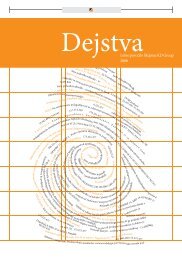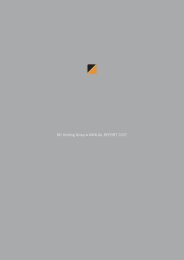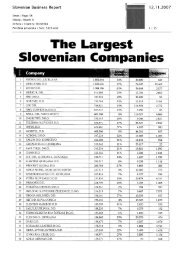The Group KD Group and KD Group dd
The Group KD Group and KD Group dd
The Group KD Group and KD Group dd
You also want an ePaper? Increase the reach of your titles
YUMPU automatically turns print PDFs into web optimized ePapers that Google loves.
<strong>The</strong> <strong>Group</strong> <strong>KD</strong> <strong>Group</strong> Annual Report 2009<br />
Notes to Consolidated Financial Statements as at <strong>and</strong> for the year ended 31 December 2009<br />
period when premium allocations to the unit-linked insurance liability are reduced for upfront charges. For property insurance<br />
contracts a proportional share of acquisition costs is deducted from the unearned premium reserves. For life insurance<br />
contracts with DPF <strong>and</strong> investment contracts with DPF, acquisition costs are deducted from mathematical provisions.<br />
.<br />
2.14.1.7 Liability adequacy test<br />
On each balance sheet date, contract liability adequacy tests are carried out. <strong>The</strong> <strong>Group</strong> assesses at each reporting date<br />
whether its recognised insurance liabilities are adequate, using current estimates of future cash flows under its insurance<br />
contracts, appraisal costs <strong>and</strong> administration costs, as well as financial income from the investments to cover these liabilities.<br />
If this estimate shows that the carrying amount of insurance liabilities is not appropriate in terms of estimated future cash<br />
flows, the entire amount of the deficit is recognised in the profit or loss.<br />
<strong>The</strong> liability adequacy test is done on the basis of recognised gross liabilities. <strong>The</strong> relevant insurance assets are considered<br />
separately. In carrying out the liability adequacy test, the insurance considers only liabilities which stem from contracts listed<br />
under the insurance contract category according to the st<strong>and</strong>ard. <strong>The</strong>se liabilities include liabilities for unearned premiums,<br />
liabilities from insurance contracts, deferred agency fee costs, claims liabilities <strong>and</strong> other liabilities.<br />
If the liability adequacy test indicates inadequate liabilities, the calculation of liabilities from such insurance contracts in future<br />
periods is done on the basis of the assumption of the test which showed inadequate disclosure of liabilities.<br />
2.14.1.8 Reinsurance contracts<br />
Contracts entered into by the <strong>Group</strong> with reinsurers under which the <strong>Group</strong> is compensated for losses on one or more<br />
contracts issued by the <strong>Group</strong> <strong>and</strong> that meet the classification requirements for insurance contracts are classified as<br />
reinsurance contracts held.<br />
<strong>The</strong> benefits to which the <strong>Group</strong> is entitled under its reinsurance contracts held are recognised as reinsurance assets. <strong>The</strong>se<br />
assets consist of short-term balances due from reinsurers, as well as long-term receivables that are dependent on the<br />
expected claims <strong>and</strong> benefits arising under the related reinsured insurance contracts. Amounts recoverable from or due to<br />
reinsurers are measured consistently with the amounts associated with the reinsured insurance contracts <strong>and</strong> in accordance<br />
with the terms of each reinsurance contract. Reinsurance liabilities are primarily premiums payable for reinsurance contracts<br />
<strong>and</strong> are recognised as an expense when due.<br />
<strong>The</strong> <strong>Group</strong> assesses its reinsurance assets for impairment on a regular basis. If there is objective evidence that the<br />
reinsurance asset is impaired, the <strong>Group</strong> reduces the carrying amount of the reinsurance asset to its recoverable amount <strong>and</strong><br />
recognises the impairment loss in the income statement.<br />
2.14.1.9 Receivables <strong>and</strong> payables related to insurance contracts<br />
Receivables <strong>and</strong> payables are recognised when due. <strong>The</strong>se include amounts due to <strong>and</strong> from agents, brokers <strong>and</strong> insurance<br />
contract holders. If there is objective evidence that the insurance receivable is impaired, the <strong>Group</strong> reduces the carrying<br />
amount of the insurance receivable accordingly <strong>and</strong> recognises that impairment loss in the income statement.<br />
2.14.1.10 Salvage <strong>and</strong> subrogation reimbursements<br />
Some insurance contracts permit the <strong>Group</strong> to sell (usually damaged) property acquired in settling a claim (i.e. salvage). <strong>The</strong><br />
<strong>Group</strong> may also have the right to pursue third parties for payment of some or all costs (i.e. subrogation).<br />
Estimates of salvage recoveries are included as an allowance in the measurement of the insurance liability for claims, <strong>and</strong><br />
salvage property is recognised in other assets when the liability is settled. <strong>The</strong> allowance is the amount that can reasonably<br />
be recovered from the disposal of the property.<br />
Subrogation reimbursements are also considered as an allowance in the measurement of the insurance liability for claims <strong>and</strong><br />
are recognised in other assets when the liability is settled. <strong>The</strong> allowance is the assessment of the amount that can be<br />
recovered from action against the liable third party.<br />
101







